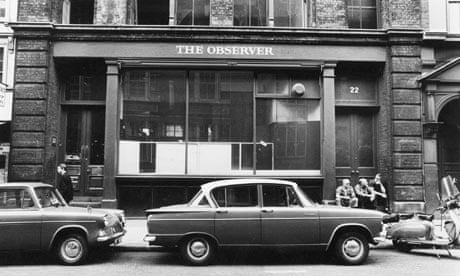As befits the oldest Sunday newspaper in the world, the history of the Observer is a volatile and varied one. The paper was founded in 1791 by WS Bourne on the simple premise that “the establishment of a Sunday newspaper would obtain him a rapid fortune”; within three years Bourne found himself £1,600 in debt. Though early editions of advertisements for the paper promised a paper “Unbiased by Prejudice - Uninfluenced by Party...Whose Principal is Independence”, Bourne attempted to cut his losses and sell the title to the government. They declined.
In its first century, the Observer was in varying degrees a scurrilous gossip sheet, government propaganda rag and provocative thorn-in-the-side of the establishment. Throughout the nineteenth century, however, the paper’s character changed and came to reflect the more sober morality of the age.
In 1820 proprietor William Innell Clement defied a government ban on reporting proceedings against the Cato Street conspirators, refused to appear in court and left a £500 fine unpaid. This victory for the freedom of the press became characteristic of the paper in future years, and was typical of the Observer as it developed a reputation for serious coverage of politics and literature.
Some glamour was restored to the title by Frederick Beer, who installed his wife Rachel (Seigfried Sassoon’s aunt) as editor in 1891. Under her control the paper achieved one of its greatest exclusives: the admission by Count Esterhazy that he had forged the letters that condemned innocent Jewish officer Captain Dreyfus to Devil’s Island. The story provoked an international outcry and led to the release and pardon of Dreyfus and court martial of Esterhazy. She was a remarkable woman - not content with running one national newspaper, she managed to combine editing the Observer with the same job at the Sunday Times.
When the Observer entered the twentieth century, the paper was owned for a brief time by Lord Northcliffe, who appointed JL Garvin to the editorship. Garvin was a maverick Tory who contrived to edit the paper almost exclusively via a special telephone line installed between the newspaper office and his luxurious house in Beaconsfield.
It was not until 1948 that the paper became genuinely free from political allegiance, when David Astor was made proprietor and editor. Astor turned the paper into a trust-owned non-party publication and helped to establish its reputation as the voice of post-war liberal Britain. During this period many famous writers were on the staff, including George Orwell, Conor Cruise O’Brien, and more infamously Kim Philby.
Between 1977 and 1993 the paper was owned by two large international companies, first Atlantic Richfield and then ‘Tiny’ Rowland’s company Lonhro. A controversial period in the paper’s history reached its climax with the bitter battle between Rowland and Mohamed Al Fayed for control of the department store Harrods. When the Department of Trade and Industry published a damning report into the conduct of Mr Fayed, editor Donald Trelford took the momentous decision to print a midweek edition of the paper.
The birth of the Independent and subsequently its sister title The Independent on Sunday increased the pressure on the Observer in what was an already crowded Sunday broadsheet market, and when it became clear that the paper was for sale a merger between the two Sunday titles was mooted. Faced with the acquisition of a natural ally by a major competitor, the Guardian Media Group acquired the Observer in 1993. As a result the Observer has been able to maintain its editorial independence, ensuring the continuation of the paper’s long-standing tradition of liberal politics and independent journalism.
The Observer has continued its reputation for setting, rather than following the news agenda, breaking stories including exposing the cash-for-access scandal dubbed Lobbygate, and leading the way in covering of issues like GM foods and cloning.
Roger Alton, editor 1998-2007, defined the paper’s stance in the context of a long and varied history: “The Observer is Britain’s oldest Sunday newspaper and it has been making mischief, poking its nose where it shouldn’t and reporting the best in arts, culture, politics, sport, business and skulduggery for over two hundred years. We aim to keep it that way and maintain its position as Britain’s most exciting Sunday newspaper.”
On 8 January 2006 The Observer relaunched in a Berliner format becoming the UK’s only full colour Sunday newspaper, and in 2007 The Observer was named national newspaper of the year at the British Press Awards.
In January 2008 John Mulholland was appointed editor of the Observer, replacing Roger Alton who had edited the paper since 1998. At the end of 2008 The Observer moved from its home in Herbal Hill, Farringdon, to new offices shared with the Guardian in King’s Cross.
Following a series of discussions concerning the role of a Sunday paper in an age when newspapers have radically changed, a redesigned Observer was launched in February 2010. The paper is now published as a four-section paper - News, Sport, the Observer Magazine and our New Review section, plus our monthly Observer Food magazine.
In June 2011 Guardian News & Media (GNM), publisher of the Guardian and Observer newspapers, announced plans to become a digital-first organisation, placing open journalism on the web at the heart of its strategy. Since the launch of the strategy The Observer has been made available on a range of new digital platforms including the iPad and Kindle.
In January 2018, a redesigned Observer website was launched to tie in with the new tabloid Guardian. The first tabloid Observer was published on 21 January. In the same month Paul Webster succeeded John Mulholland as editor.







